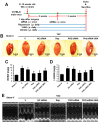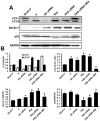PKD knockdown inhibits pressure overload-induced cardiac hypertrophy by promoting autophagy via AKT/mTOR pathway
- PMID: 28367092
- PMCID: PMC5370435
- DOI: 10.7150/ijbs.17617
PKD knockdown inhibits pressure overload-induced cardiac hypertrophy by promoting autophagy via AKT/mTOR pathway
Abstract
Growing evidence shows that protein kinase D (PKD) plays an important role in the development of pressure overload-induced cardiac hypertrophy. However, the mechanisms involved are not clear. This study tested our hypothesis that PKD might mediate cardiac hypertrophy by negatively regulating autophagy using the technique of PKD knockdown by siRNA. Cardiac hypertrophy was induced in 8-week old male C57BL/6 mice by transverse aortic constriction (TAC). TAC mice were then divided into five groups receiving the treatments of vehicle (DMSO), an autophagy inducer rapamycin (1 mg/kg/day, i.p.), control siRNA, lentiviral PKD siRNA (2×108 transducing units/0.1 ml, i.v. injection in one day after surgery, and repeated in 2 weeks after surgery), and PKD siRNA plus 3-methyladenine (3-MA, an autophagy inhibitor, 20 mg/kg/day, i.p.), respectively. Four weeks after TAC surgery, echocardiographic study, hematoxylin and eosin (HE) staining, and Masson's staining showed mice with TAC had significantly hypertrophy and remodeling compared with sham animals. Treatments with PKD siRNA or rapamycin significantly ameliorated the cardiac hypertrophy and dysfunction. Moreover, PKD siRNA increased cardiac autophagic activity determined by electron micrographic study and the biomarkers by Western blot, accompanied with the downregulated AKT/mTOR/S6K signaling pathway. All the cardiac effects of PDK knockdown were inhibited by co-treatment with 3-MA. These results suggest that PKD is involved in the development of cardiac hypertrophy by inhibiting cardiac autophagy via AKT/mTOR pathway.
Keywords: AKT/mTOR pathway; PKD knockdown; autophagy; cardiac hypertrophy; pressure overload.
Conflict of interest statement
Conflict of Interest: The authors declare no conflict of interest.
Figures






Similar articles
-
PKD deletion promotes autophagy and inhibits hypertrophy in cardiomyocyte.Exp Cell Res. 2020 Jan 15;386(2):111742. doi: 10.1016/j.yexcr.2019.111742. Epub 2019 Nov 21. Exp Cell Res. 2020. PMID: 31759056
-
Melatonin ameliorates pressure overload-induced cardiac hypertrophy by attenuating Atg5-dependent autophagy and activating the Akt/mTOR pathway.Biochim Biophys Acta Mol Basis Dis. 2020 Oct 1;1866(10):165848. doi: 10.1016/j.bbadis.2020.165848. Epub 2020 May 28. Biochim Biophys Acta Mol Basis Dis. 2020. PMID: 32473999
-
GPR30 Alleviates Pressure Overload-Induced Myocardial Hypertrophy in Ovariectomized Mice by Regulating Autophagy.Int J Mol Sci. 2023 Jan 4;24(2):904. doi: 10.3390/ijms24020904. Int J Mol Sci. 2023. PMID: 36674423 Free PMC article.
-
Autophagy and pressure overload-induced cardiac hypertrophy.J Asian Nat Prod Res. 2022 Dec;24(12):1101-1108. doi: 10.1080/10286020.2021.2024810. Epub 2022 Jan 19. J Asian Nat Prod Res. 2022. PMID: 35043747 Review.
-
Autophagy modulation: a potential therapeutic approach in cardiac hypertrophy.Am J Physiol Heart Circ Physiol. 2017 Aug 1;313(2):H304-H319. doi: 10.1152/ajpheart.00145.2017. Epub 2017 Jun 2. Am J Physiol Heart Circ Physiol. 2017. PMID: 28576834 Free PMC article. Review.
Cited by
-
The Protective Role of TLR2 Mediates Impaired Autophagic Flux by Activating the mTOR Pathway During Neospora caninum Infection in Mice.Front Cell Infect Microbiol. 2021 Nov 26;11:788340. doi: 10.3389/fcimb.2021.788340. eCollection 2021. Front Cell Infect Microbiol. 2021. PMID: 34900761 Free PMC article.
-
The role of post-translational modifications in cardiac hypertrophy.J Cell Mol Med. 2019 Jun;23(6):3795-3807. doi: 10.1111/jcmm.14330. Epub 2019 Apr 4. J Cell Mol Med. 2019. PMID: 30950211 Free PMC article. Review.
-
The Role of Oxidative Stress in Cardiac Disease: From Physiological Response to Injury Factor.Oxid Med Cell Longev. 2020 May 14;2020:5732956. doi: 10.1155/2020/5732956. eCollection 2020. Oxid Med Cell Longev. 2020. PMID: 32509147 Free PMC article. Review.
-
Modulation of Titin-Based Stiffness in Hypertrophic Cardiomyopathy via Protein Kinase D.Front Physiol. 2020 Apr 15;11:240. doi: 10.3389/fphys.2020.00240. eCollection 2020. Front Physiol. 2020. PMID: 32351396 Free PMC article.
-
Potassium Alginate Oligosaccharides Alter Gut Microbiota, and Have Potential to Prevent the Development of Hypertension and Heart Failure in Spontaneously Hypertensive Rats.Int J Mol Sci. 2021 Sep 11;22(18):9823. doi: 10.3390/ijms22189823. Int J Mol Sci. 2021. PMID: 34575987 Free PMC article.
References
MeSH terms
Substances
LinkOut - more resources
Full Text Sources
Other Literature Sources
Miscellaneous

